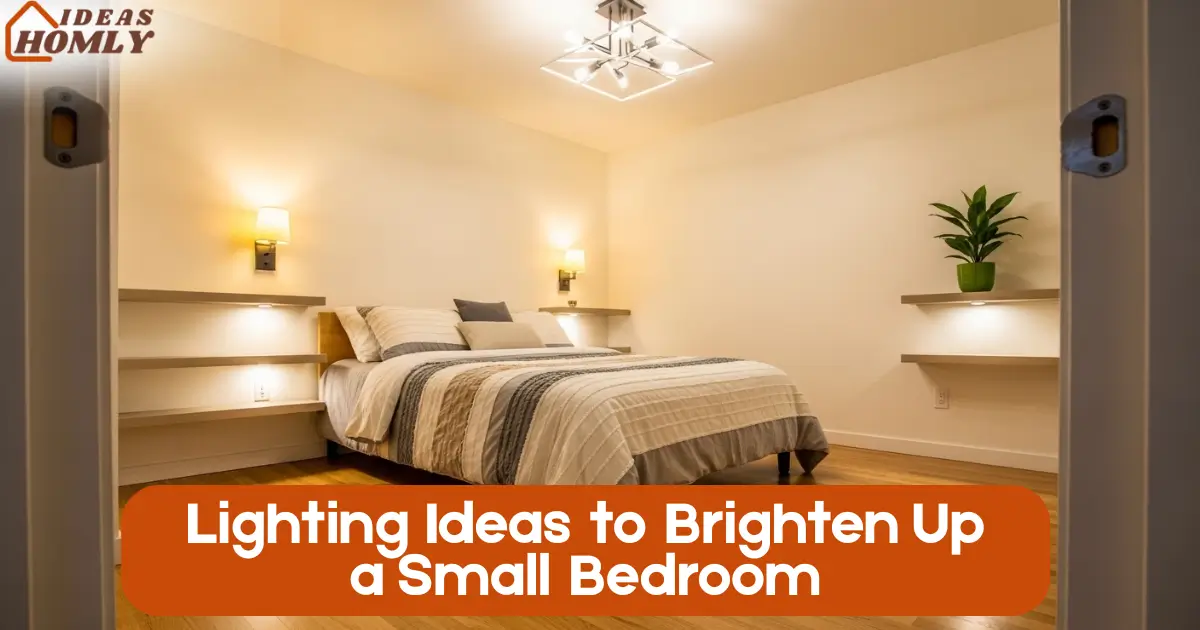If your small bedroom feels dim, it’s not just about size. It’s often the lighting that makes or breaks the atmosphere.
I’ve seen tiny rooms feel open and inviting with the right lighting choices, and I’ve also seen beautiful spaces ruined by bad placement or outdated fixtures.
Good lighting doesn’t just help you see but it sets the mood, creates depth, and makes your space feel more comfortable.
When I started updating my own bedroom lighting, I realized that it wasn’t about cramming in more lamps. It was about choosing the right combination of light sources, fixtures, and positions to get maximum brightness without clutter.
In this guide, I’ll share lighting ideas that not only brighten your small bedroom but also add character and functionality.
Role of Lighting in Small Space Design
Lighting plays a big role in making a small bedroom feel bigger. I like to think of it as a tool for shaping the room’s mood and dimensions.
With careful placement and layering, you can highlight certain areas, draw attention away from tight corners, and create an airy, open feel.
A lot of people make the mistake of relying on a single overhead bulb, but that often casts harsh shadows and makes the space feel closed in. Instead, combining ambient, task, and accent lighting gives depth and balance.
This approach not only makes the room brighter but also helps in defining separate areas like your reading nook or dressing corner without using walls or bulky dividers.
1. Layered Lighting Plan
A layered lighting plan is my go-to method for making any bedroom shine literally and figuratively. Instead of depending on one fixture, I like to use a mix of lighting types that work together.
Here’s how I usually break it down:
- Ambient lighting for general brightness
- Task lighting for focused activities like reading or working
- Accent lighting for highlighting décor or architectural details
For example, in my own space, I combined a ceiling light with two adjustable wall sconces and a small LED strip under a floating shelf.
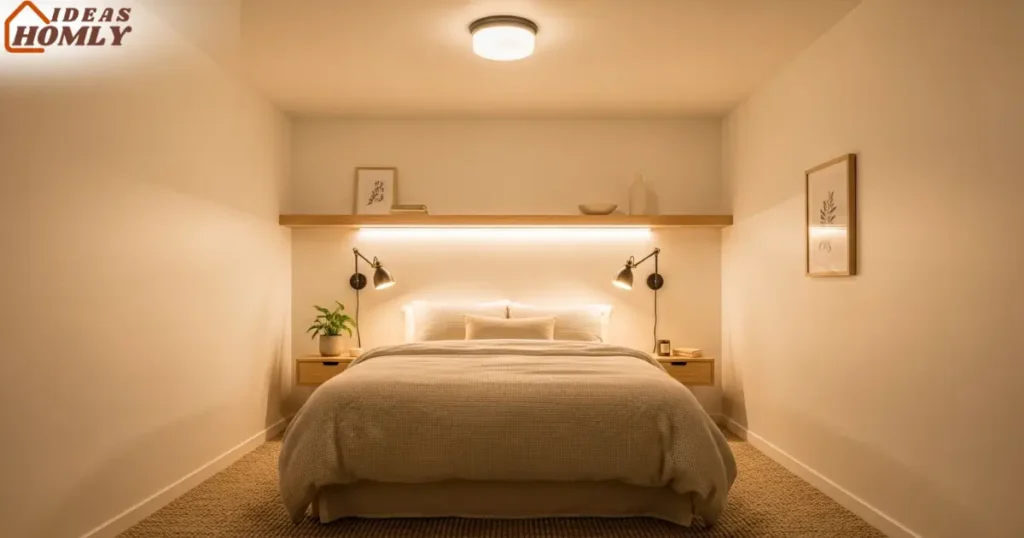
The result? Every corner feels lit without being overwhelming. This also lets me adjust the brightness depending on the time of day or my mood.
Always use dimmable bulbs where possible. This gives you flexibility and helps avoid harsh glare at night. I also recommend sticking to warm white bulbs for a cozy look, while keeping daylight bulbs for tasks that need sharp visibility.
2. Large Shallow Flush-Mount Fixture
If your ceiling is low, a large shallow flush-mount fixture can make a world of difference. I used to think these were outdated until I saw how modern designs can spread light evenly without eating into headroom.
The beauty of a large, shallow fixture is that it distributes light across the ceiling and walls, eliminating shadows that make the room feel smaller.
In my bedroom, I swapped out an old pendant for a sleek 20-inch flush mount with a frosted diffuser, and it instantly brightened the whole room.
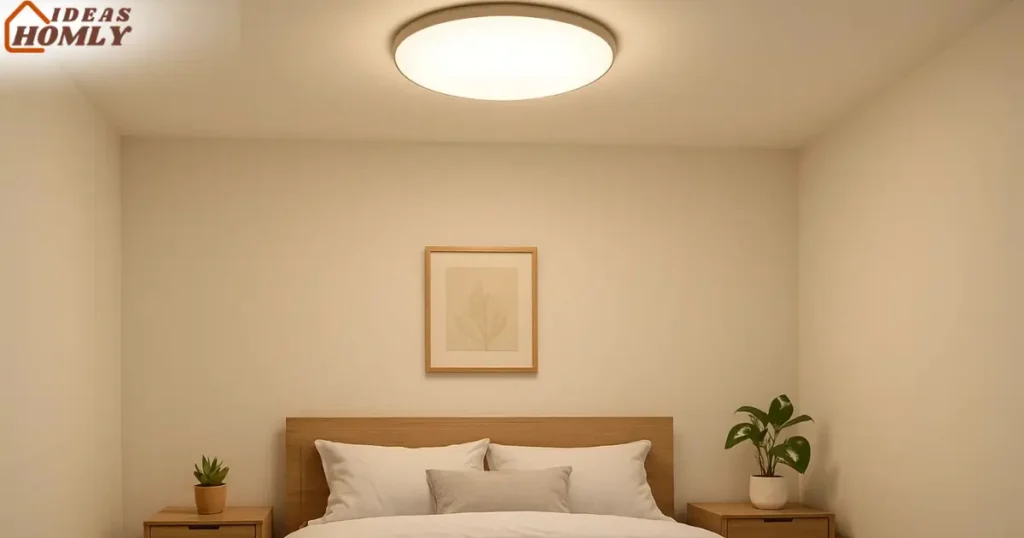
To make it even better, choose a fixture with a wide LED panel. It not only saves energy but also reduces the need for multiple extra lights.
If you want a softer look, pick one with a fabric shade or frosted glass as it gives a warm, inviting glow that flatters both the room and your mood.
3. String, Fairy, or Cove LEDs
I’ve always loved how string and fairy lights instantly change a room’s mood. They add a soft, diffused glow that fills dark corners without overpowering the space.
In a small bedroom, I like to use them around the headboard, along floating shelves, or even tucked under the bed frame for a subtle halo effect.
If you want a cleaner, more permanent option, Cove LEDs are a great choice. I once installed them along the top edge of my wardrobe, and it created a floating ceiling effect. It made the room feel taller and more open, all without bulky fixtures.
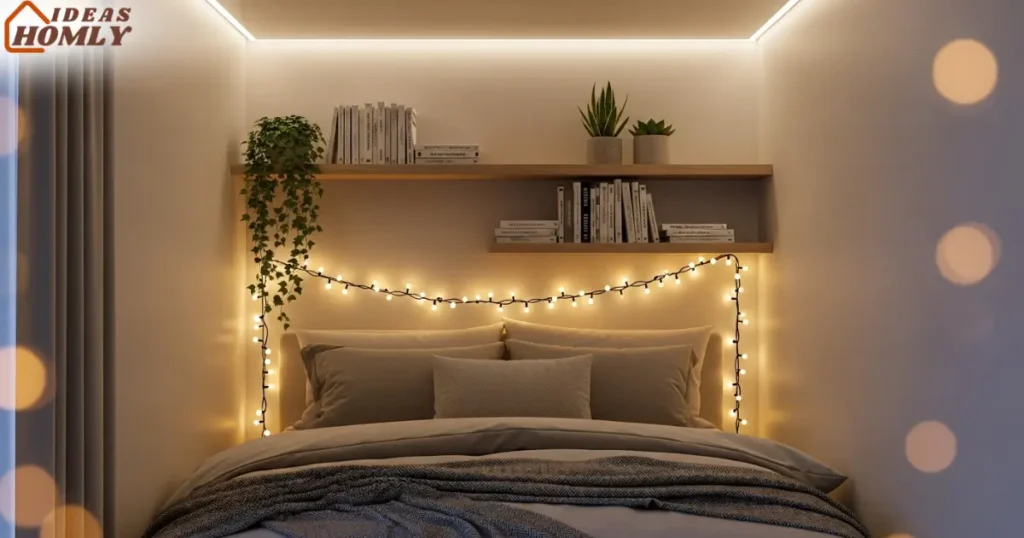
The trick is to pick warm white or neutral tones. Bright, cool lights can make the room feel harsh, while warmer tones create a cozy atmosphere perfect for winding down at night.
For flexibility, I use plug-in LED strips with a remote, so I can switch between bright task lighting and softer evening light without changing bulbs.
4. Wall Lighting Instead of Table Lamps
Small bedrooms often don’t have the luxury of large nightstands, and that’s where wall-mounted lighting comes to the rescue.
I replaced my bedside table lamps with swing-arm wall sconces, and not only did it free up space, but it also made the room look more streamlined.
Wall lighting helps eliminate clutter and keeps surfaces open for books, plants, or that morning coffee mug. Adjustable sconces let you direct light exactly where you need it whether you’re reading in bed or just want ambient light for relaxing.
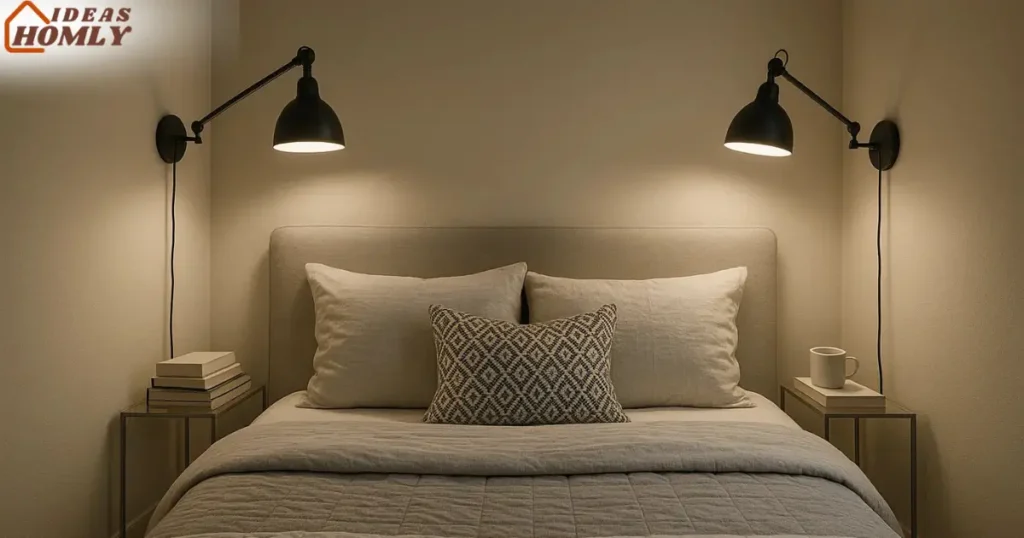
If wiring is a hassle, I suggest going for plug-in wall lights or even battery-operated sconces. I’ve tried peel-and-stick battery lights with a faux brass finish, and they looked surprisingly high-end. Moreover, I didn’t have to drill or run cables across the wall, which is a big win in a rental.
Mistakes to Avoid in Small Bedroom Lighting
Over the years, I’ve noticed a few common lighting mistakes that instantly make a small bedroom feel cramped or uncomfortable:
- Using only one light source: This creates harsh shadows and leaves parts of the room feeling dark.
- Choosing oversized fixtures for the wrong space: While large lights can work, they need to be proportionate to your ceiling height and room size.
- Ignoring bulb temperature: Mixing warm and cool bulbs can make lighting look inconsistent and unbalanced.
- Blocking natural light: Heavy curtains or poorly placed furniture can waste precious daylight.
I’ve made some of these mistakes myself, and fixing them instantly improved the look and feel of the space.
Conclusion
Brightening a small bedroom isn’t about adding as many lights as possible rather it’s about making each light count.
From layered lighting plans to smart fixture choices, every decision shapes how your room feels. I’ve found that combining ceiling, wall, and accent lights gives the most flexibility and comfort.
If there’s one takeaway from my own experience, it’s this: think of lighting as part of your bedroom’s design, not just a functional afterthought.
The right lighting makes the space look bigger, sets the perfect mood, and turns even the smallest room into a place you genuinely enjoy spending time in.
FAQs
I recommend at least three different types; ambient, task, and accent lighting. This balance ensures the room is evenly lit, avoids harsh shadows, and gives you flexibility depending on the activity. Even in a tiny room, a layered plan makes it feel brighter and more welcoming.
You can, but I usually avoid them unless they’re slim and placed in unused corners. Floor lamps take up valuable floor space, so I prefer wall-mounted or ceiling lights for small rooms.
If you really want one, choose a design with a narrow base and an adjustable arm to save space.
For a cozy, relaxing atmosphere, I stick with warm white bulbs (2700K to 3000K). If you need brighter, more energizing light for tasks like makeup or studying, you can use daylight bulbs (4000K to 5000K) in targeted areas, but avoid them for general ambient lighting.
Yes, they’re my go-to choice. LEDs are energy-efficient, last for years, and come in various brightness levels and color temperatures.
I also like how modern LEDs can be dimmed or even color-tuned, giving you control over the mood of the room without changing the fixture.

